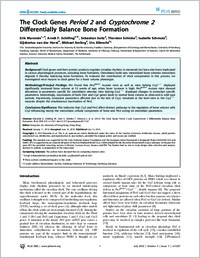the clock genes Period 2 and Cryptochrome 2 differentially balance bone formation
- Maronde, Erik Senckenbergische Anatomie, Institute for Anatomy III, Goethe University, Frankfurt, Germany
- Schilling, Arndt F. Department of Osteology and Biomechanics, University of Hamburg, Germany - Biomechanics Section, Hamburg University of Technology, Germany
- Seitz, Sebastian Department of Osteology and Biomechanics, University of Hamburg, Germany
- Schinke, Thorsten Department of Osteology and Biomechanics, University of Hamburg, Germany
- Schmutz, Isabelle Unit of Biochemistry, Department of Medicine, University of Fribourg, Switzerland
- Horst, Gijsbertus van der Department of Genetics, Centre for Biomedical Genetics, Erasmus University Medical Centre, Rotterdam, The Netherlands
- Amling, Michael Department of Osteology and Biomechanics, University of Hamburg, Germany
- Albrecht, Urs Unit of Biochemistry, Department of Medicine, University of Fribourg, Switzerland
-
12.07.2010
Published in:
- PLoS One. - 2010, vol. 5, no. 7, p. e11527
English
Background: Clock genes and their protein products regulate circadian rhythms in mammals but have also been implicated in various physiological processes, including bone formation. Osteoblasts build new mineralized bone whereas osteoclasts degrade it thereby balancing bone formation. To evaluate the contribution of clock components in this process, we investigated mice mutant in clock genes for a bone volume phenotype.Methodology/Principal Findings: We found that Per2Brdm1 mutant mice as well as mice lacking Cry2−/− displayed significantly increased bone volume at 12 weeks of age, when bone turnover is high. Per2Brdm1 mutant mice showed alterations in parameters specific for osteoblasts whereas mice lacking Cry2−/− displayed changes in osteoclast specific parameters. Interestingly, inactivation of both Per2 and Cry2 genes leads to normal bone volume as observed in wild type animals. Importantly, osteoclast parameters affected due to the lack of Cry2, remained at the level seen in the Cry2−/− mutants despite the simultaneous inactivation of Per2.Conclusions/Significance: This indicates that Cry2 and Per2 affect distinct pathways in the regulation of bone volume with Cry2 influencing mostly the osteoclastic cellular component of bone and Per2 acting on osteoblast parameters.
- Faculty
- Faculté des sciences et de médecine
- Department
- Département de Biologie
- Language
-
- English
- Classification
- Biological sciences
- License
- License undefined
- Identifiers
-
- RERO DOC 20228
- DOI 10.1371/journal.pone.0011527
- Persistent URL
- https://folia.unifr.ch/unifr/documents/301743
Statistics
Document views: 58
File downloads:
- alb_cgp.pdf: 126
